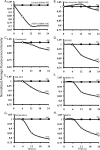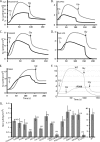Use of kinase inhibitors to correct ΔF508-CFTR function
- PMID: 22700489
- PMCID: PMC3434788
- DOI: 10.1074/mcp.M111.016626
Use of kinase inhibitors to correct ΔF508-CFTR function
Abstract
The most common mutation in cystic fibrosis (CF) is a deletion of Phe at position 508 (ΔF508-CFTR). ΔF508-CFTR is a trafficking mutant that is retained in the ER, unable to reach the plasma membrane. To identify compounds and drugs that rescue this trafficking defect, we screened a kinase inhibitor library enriched for small molecules already in the clinic or in clinical trials for the treatment of cancer and inflammation, using our recently developed high-content screen technology (Trzcinska-Daneluti et al. Mol. Cell. Proteomics 8:780, 2009). The top hits of the screen were further validated by (1) biochemical analysis to demonstrate the presence of mature (Band C) ΔF508-CFTR, (2) flow cytometry to reveal the presence of ΔF508-CFTR at the cell surface, (3) short-circuit current (Isc) analysis in Ussing chambers to show restoration of function of the rescued ΔF508-CFTR in epithelial MDCK cells stably expressing this mutant (including EC(50) determinations), and importantly (4) Isc analysis of Human Bronchial Epithelial (HBE) cells harvested from homozygote ΔF508-CFTR transplant patients. Interestingly, several inhibitors of receptor Tyr kinases (RTKs), such as SU5402 and SU6668 (which target FGFRs, VEGFR, and PDGFR) exhibited strong rescue of ΔF508-CFTR, as did several inhibitors of the Ras/Raf/MEK/ERK or p38 pathways (e.g. (5Z)-7-oxozeaenol). Prominent rescue was also observed by inhibitors of GSK-3β (e.g. GSK-3β Inhibitor II and Kenpaullone). These results identify several kinase inhibitors that can rescue ΔF508-CFTR to various degrees, and suggest that use of compounds or drugs already in the clinic or in clinical trials for other diseases can expedite delivery of treatment for CF patients.
Figures






Similar articles
-
RNA Interference Screen to Identify Kinases That Suppress Rescue of ΔF508-CFTR.Mol Cell Proteomics. 2015 Jun;14(6):1569-83. doi: 10.1074/mcp.M114.046375. Epub 2015 Mar 29. Mol Cell Proteomics. 2015. PMID: 25825526 Free PMC article.
-
Tgf-β1 inhibits Cftr biogenesis and prevents functional rescue of ΔF508-Cftr in primary differentiated human bronchial epithelial cells.PLoS One. 2013 May 9;8(5):e63167. doi: 10.1371/journal.pone.0063167. Print 2013. PLoS One. 2013. PMID: 23671668 Free PMC article.
-
Low temperature and chemical rescue affect molecular proximity of DeltaF508-cystic fibrosis transmembrane conductance regulator (CFTR) and epithelial sodium channel (ENaC).J Biol Chem. 2012 May 11;287(20):16781-90. doi: 10.1074/jbc.M111.332031. Epub 2012 Mar 22. J Biol Chem. 2012. PMID: 22442149 Free PMC article.
-
CFTR: folding, misfolding and correcting the ΔF508 conformational defect.Trends Mol Med. 2012 Feb;18(2):81-91. doi: 10.1016/j.molmed.2011.10.003. Epub 2011 Dec 3. Trends Mol Med. 2012. PMID: 22138491 Free PMC article. Review.
-
Protein processing and inflammatory signaling in Cystic Fibrosis: challenges and therapeutic strategies.Curr Mol Med. 2010 Feb;10(1):82-94. doi: 10.2174/156652410791065408. Curr Mol Med. 2010. PMID: 20205681 Free PMC article. Review.
Cited by
-
Cystic fibrosis transmembrane conductance regulator-emerging regulator of cancer.Cell Mol Life Sci. 2018 May;75(10):1737-1756. doi: 10.1007/s00018-018-2755-6. Epub 2018 Feb 6. Cell Mol Life Sci. 2018. PMID: 29411041 Free PMC article. Review.
-
Identification of p38 MAPK and JNK as new targets for correction of Wilson disease-causing ATP7B mutants.Hepatology. 2016 Jun;63(6):1842-59. doi: 10.1002/hep.28398. Epub 2016 Jan 25. Hepatology. 2016. PMID: 26660341 Free PMC article.
-
Comprehensive Profiling and Therapeutic Insights into Differentially Expressed Genes in Hepatocellular Carcinoma.Cancers (Basel). 2023 Nov 30;15(23):5653. doi: 10.3390/cancers15235653. Cancers (Basel). 2023. PMID: 38067357 Free PMC article.
-
A high-throughput 3D cantilever array to model airway smooth muscle hypercontractility in asthma.APL Bioeng. 2023 May 16;7(2):026104. doi: 10.1063/5.0132516. eCollection 2023 Jun. APL Bioeng. 2023. PMID: 37206658 Free PMC article.
-
Proteostasis Regulators in Cystic Fibrosis: Current Development and Future Perspectives.J Med Chem. 2022 Apr 14;65(7):5212-5243. doi: 10.1021/acs.jmedchem.1c01897. Epub 2022 Apr 4. J Med Chem. 2022. PMID: 35377645 Free PMC article. Review.
References
-
- Boucher R. C. (2007) Airway surface dehydration in cystic fibrosis: pathogenesis and therapy. Annu. Rev. Med. 58, 157–170 - PubMed
-
- Donaldson S. H., Boucher R. C. (2007) Sodium channels and cystic fibrosis. Chest 132, 1631–1636 - PubMed
-
- Ratjen F. A. (2009) Cystic fibrosis: pathogenesis and future treatment strategies. Respir. Care 54, 595–605 - PubMed
-
- Riordan J. R. (2008) CFTR function and prospects for therapy. Annu. Rev. Biochem. 77, 701–726 - PubMed
-
- Riordan J. R. (2005) Assembly of functional CFTR chloride channels. Annu. Rev. Physiol. 67, 701–718 - PubMed
Publication types
MeSH terms
Substances
Grants and funding
LinkOut - more resources
Full Text Sources
Other Literature Sources
Medical
Research Materials
Miscellaneous

